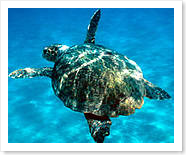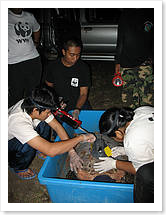26 Aug 2008
 Santiago de Cali, Colombia - Alternative fishing technology has been shown to save turtles while not affecting fish catches, according to a report released by WWF and the Inter-American Tropical Tuna Commission (IATTC).
Santiago de Cali, Colombia - Alternative fishing technology has been shown to save turtles while not affecting fish catches, according to a report released by WWF and the Inter-American Tropical Tuna Commission (IATTC).
The report demonstrates how changing from the classic J hook to circular hooks, providing adequate training and tools to release turtles accidentally hooked and enhancing sustainable fishing practices, can dramatically reduce incidental catch (bycatch) of marine turtles without impacting fishing activity.
“The results keep demonstrating that changing to circular hooks is the right choice, since it favours turtle conservation without having an impact on the economy of artisanal fisheries. Together with fishermen we are building a culture for sustainable fishing practices that will guarantee fish stocks in the long term,” said Moises Mug, Coordinator of the WWF Bycatch Initiative for the Eastern Pacific.
The report - Bycatch Initiative: Eastern Pacific Program, A Vehicle Towards Sustainable Fisheries - is a comprehensive analysis of data collected during four years of work in eight different countries in the Eastern Pacific - Mexico, Panama, Costa Rica, El Salvador, Guatemala, Colombia, Ecuador and Peru.
“Our goal is to reduce the incidental catch of marine turtles from the long-line fishing operations without affecting the fisheries activity which is a main source of food and income for local communities,” explained Martin Hall, Principal Researcher for the IATTC.
The program was carried out with the voluntary participation of nearly 1,300 fishermen, conducting over 1,400 fishing trips on 305 artisanal fishing boats. Data gathered by independent on-board observers show an overall significant trend of bycatch reduction for both TBS (tuna, billfishes and sharks) and mahi-mahi fisheries, with reductions up to 89% in the marine turtle bycatch per thousand hooks; 95% of all turtles caught in long-line fishing were recovered alive; and circle hooks performed as well as J hooks in the catch rates of tuna, billfishes and sharks fishery.
“This programme is going beyond an initial focus of saving sea turtles from bycatch, and is creating the groundwork toward sustainable artisanal long-line fishing in the eastern Pacific,” said Amanda Nickson, Global Leader of WWF’s Bycatch Initiative.
“By working co-operatively, collecting data and learning how to improve practices, this programme is living proof that conservation and industry can work together for sustainability.”
END
Editor’s Notes
- Participants to this program are: the Inter-American Tropical Tuna Commission (IATTC), The National Oceanic and Atmospheric Administration (NOAA), The Ocean Conservancy, the Western Pacific Regional Fishery Management Council (WPRFMC), Overseas Fisheries Cooperation Foundation of Japan (OFCF - Japan), and WWF (Known as World Wildlife Fund in the United States and Canada).
- The WWF Regional Bycatch Program for the Eastern Pacific develops, test, and implement new fisheries techniques that reduce Bycatch (incidental capture of sea turtles). It also works on sea turtle conservation by developing legislative framework on bycatch, and raising awareness among fisheries communities about sustainable fishing.
The Program seeks a participatory approach by working with fisheries’ organizations, fishing companies and captains, fisheries authorities, academic and training institutions, buyers, exporters, and local NGOs. Currently, the program is being carried out in eight countries: Peru, Ecuador, Colombia, Panama, Costa Rica, Guatemala, El Salvador, and Mexico. Nicaragua is expected to join next.
Basic components of the program include: recruiting partners; talking to fishermen to get them to try circle hooks instead of the classic “J” hooks; training observers to collect data on the fish that are caught as well as the sea turtles that are incidentally catch; providing gear and techniques to fishermen to release marine turtles, as well as enhancing sustainable fisheries practices.
Two-tailed Wilcoxon Signed-Rank tests for matched pairs were used to analyze the overall trend of the difference in hooking rates for J hooks and circle hooks. This non-parametric, two-tailed test considers both the direction of the difference between hooks and the magnitude of the observed difference.
Main challenges for the near future include a) how to make the circular hooks available in the marketplace at reasonable and competitive prices; b) how to encourage the institutional adoption of the fishing observers program by local actors for sustainability in the medium and long terms; c) carrying out education and communications campaigns; d) facilitating technological adaptation and transformation of the fishing fleet with appropriate regulatory measures; and e) developing potential markets for fish coming from fisheries with circular hooks and turtle-friendly practices.
Further information
Julio Mario Fernández b
Communications Coordinator - WWF Bycatch Initiative in the eastern Pacific
Communications Director - WWF Colombia
Tel + 57 2 558 25 77 Ext 117
Cel + 57 315 491 15 69 / 313 765 98 06
jmfernandez@wwf.org.co


 This research, the third year running, is being conducted to discover the foraging habitat of the hawksbills nesting along the Melaka coastline and their migration patterns in the Strait of Malacca. The research data gathered is crucial in identifying and reducing threats to the turtles’ marine habitat, where they spend most of their lives. These hawksbills undertake their long journey every few years to Melaka beaches solely to complete their reproductive cycle.
This research, the third year running, is being conducted to discover the foraging habitat of the hawksbills nesting along the Melaka coastline and their migration patterns in the Strait of Malacca. The research data gathered is crucial in identifying and reducing threats to the turtles’ marine habitat, where they spend most of their lives. These hawksbills undertake their long journey every few years to Melaka beaches solely to complete their reproductive cycle.
